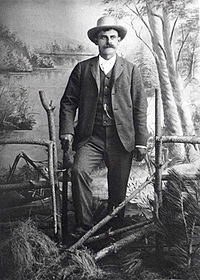John Bernhard Leiberg
John Bernhard Leiberg (1853–1913) was a Swedish botanical explorer, forester, and bryologist in the northwestern United States. Leiberg came to America in 1868 and settled near Lake Coeur d'Alene, Idaho. He spent the first part of his career as an explorer and plant collector for various flora projects mainly in Idaho, Washington, Oregon, and Nevada. Later he worked with the United States Geological Survey. With little formal education, at age 17 he began publishing plant collections and in 1884 he and his wife, Carrie, settled n the Lake Pend Oreille, Idaho Territory. His wife was a doctor and surgeon. He supplied specimens to the New York Botanical Garden and in 1892 he spent the winter in Hamilton, Montana. He worked as a field botanist for Frederic Coville, curator of the US National Herbarium and in 1897 he was transferred to the US Geological Survey and assigned to examine the area of the 6480 square mile Bitterroot Forest Reserve which later became National Forests in Montana and Idaho. (The reserves had been expanded by President Grover Cleveland by his February 22, 1897 proclamation.) He surveyed the Bitterroot reserve in 1897 and 1898 and wrote the 19th and 20th annual reports for the US Geological Survey describing the topography, trees and mapping locations in an area previously relatively undocumented. From 1900 to 1904 he published descriptions of several other western forest reserves. He spent a short time in the Philippines, a US protectorate, where he was a forest inspector for the Insular Forest Service. He left government service in 1906 and briefly settled on a farm in Eugene, Oregon. He traveled the world in 1910 and died in 1913. He contributed to and authored many publications including Contributions to the Flora of Idaho and Minnesota and many forestry related works. sa
Personal facts

| Birth date | October 07, 1853 |
|---|---|
| Birth place | |
| Date of death | October 28, 1913 |
| Place of death |